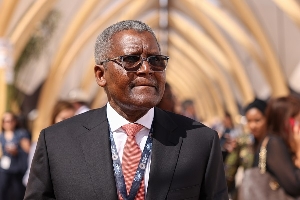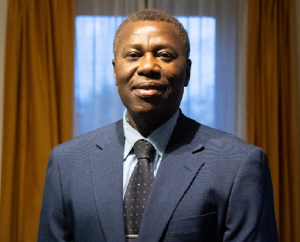TITLE OF BOOK: Development In Unity Volume One: Compendium of Works of Daasebre Prof.(Emeritus) Oti Boateng
AUTHOR: Daasebre Prof. (Emeritus) Oti Boateng, Paramount Chief of New Juaben Traditional Area.
REVIEW BY: Nyaaba-Aweeba Azongo, Development Planner/Consultant
Development in Unity Volume One is written by Daasebre Prof. (Emeritus) Oti Boateng, who is undoubtedly one of the towering African scholars recognized by the Distinguished Scholars of Africa with the Distinguished Fellow award and acknowledged as one of the greatest minds of the 21st century by the American Biographical Institute.
In this publication, the author weaves his personal experiences, beliefs, philosophy and the culture of his people into a well-sequenced prolific presentation of popular development themes to feed into a particular thought evolution as an instrument of change. This is a complete departure from the usual biographic presentation of shared personal episode and the singular Legendary-Anchor of Daasebre’s scholarly piece which could influence the global biographical outlook –a shift towards the attainment of institutional essence in the preservation of individual exploits.
The book depicts the writer’s deep sense of history by reproducing with amazing clarity records of events that involved him from as far back as the second world-war through Ghana’s independence era to the most recent times. The compendium exudes a distinctive compass of lessons for posterity and a pillar of enduring legacy. It is a treasure house of personal experience laced-through relevant themes of development in a single volume. The book is iconic in many respects, a break-away brand, a bridge of culture and scholarship and a masterpiece of art that conveys passion, intellectual astuteness and charisma driven by a vision for development.
In both history and literary substance the compendium is a memory bank of the writer’s exploits as a scholar and a cultural activist blending culture, modernism and scholarship in rare harmony. It is a fountain of inspiration which could constitute an African chapter in the quest to author a new development order.
The book is a collection of thoughts and experience, an eclectic repertoire of development issues presented as a history of global exploits brewed from the cultural compass of the New Juaben Traditional State in Ghana. The book is a moment of intellectual genius which further enhances the African pride of place in global leadership and intellectual assertiveness.
This rich tapestry of the author as an eminent scholar and a renowned cultural leader has given this rare compendium life and form. This scholarly intellectual tribute is a Historic Intellectual Monument defining the place and space of the New Juaben Traditional State in Ghana’s history from a global perspective personified by the exploits of Daasebre Oti Boateng, Omanhene of New Juaben, who has earned an enviable and unique recognition in the ancestral edifice of chieftaincy.
The most iconic attribute of the publication which gives a profound revelation of the depth of Daasebre’s creative imagination, is how the book has been skillfully dovetailed into the Akwantukese Festival, a post-independence traditional Festival in Ghana pioneered by the author as the Omanhene to bring an important part of Asante history, the Great Migration, into contemporary significance. He presents the book blended with his exploits as part of an institution expertly designed for national and global consumption – a historic threshold of New Juaben footprint in Ghana, Africa and global development. In this context, the book attains an institutional legitimacy as a product of the institution of New Juaben and Asante history and not just as an individual scholarly piece of personal episode.
Daasebre’s exploits and achievements have helped to place the twin-brand of the Akwantukese Festival and the New Juaben Traditional State on the prized global tourism map. Furthermore, by its philosophy and design the book co-evolves with the festival giving it a permanent presence in history and inter-generational essence.
As a development planner and a passionate development activist, I am inspired by the writer’s depth of appreciation on issues of development sustainability. The Root-based Model, ’ a theory of development the author propounded and presented to the UN Secretary-General as a Commissioner to the UN and at the World Forum of Academicians in Cambridge University, England, has been comprehensively treated in the book as a resource-pool for national development planning. The Root-Based Model which has received the approbation of high-profile institutions world-wide advocates tapping into the inner sub-stratum of our identity as a people for the utilization of indigenous traditional knowledge and the age-old internalized community support systems which are necessary prerequisites for sustainable development. The depth of development planning discourse around the root-based model leaves one wondering where to position the writer in the professional scheme of things.
The preface of the book which I have christened the ‘Preface of Inspiration’ sets an interesting inspirational premise on the aegis of change and culture. It builds on the author’s perspective of change from authoritative references to underline his beliefs, philosophy and projections.
The author uniquely treats the concept of change with a quote from Mahatma Gandhi: “Constant development is the law of life and a man who always tries to maintain his dogmas in order to appear constant drives himself into a false position”. Flowing from Mahatma Gandhi’s statement, the writer evolved his concept of change: “change is a continuous process and we must endeavour to contribute positively to the change that envelopes our individual as well as community lives. But for change to be meaningful, useful and relevant, it must enhance our efforts at developing ourselves, our communities, our nation and our world at large”.
The writer underlines the fact that “Being the custodian of the rich culture of my people also involves challenging them to explore effective ways of making the necessary adjustments in our culture so as to meet the challenges of our times while trying to preserve the best in our culture for the benefit of future generations. In our attempt to maintain a dynamic culture, we are mindful of the fact that no culture can live in exclusivity. That is why in my travels throughout the world, I constantly employ the process of feedback interactions to benefit my people. That is what I have sought to do in these publications-creating a gift for posterity”. The book indeed symbolizes one of nature’s prolific and benign gifts to the world as the author rightly acknowledges.
The striking feature of his concept of change lies in bringing two worlds: modernism and culture into a common realm, a singular course in the pursuit of humanity which could be blended in harmony to underline total Development.
This is a development book built around a personality who symbolizes it all. It is a melting pot of lessons and a must-read book for present and future leaders and in particular for the younger generation.
Opinions of Wednesday, 7 May 2014
Columnist: Azongo, Nyaaba-Aweeba














